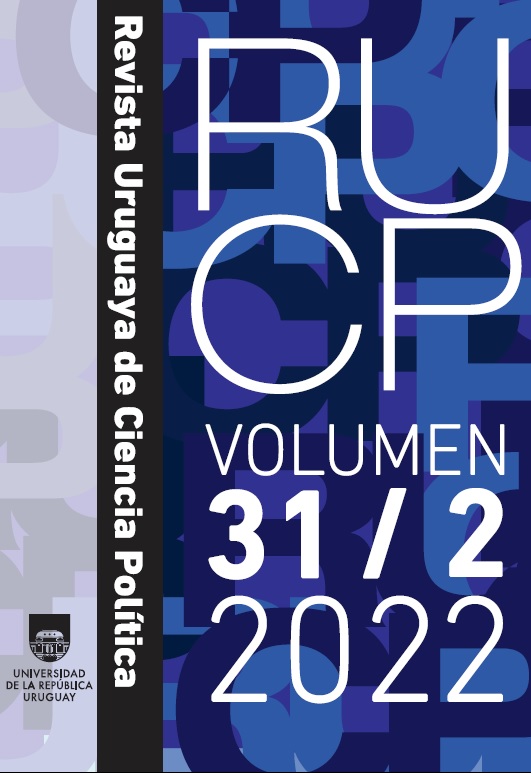Harry Blackmun y los estudios de Judicial Behavior ¿Qué podemos aprender?
DOI:
https://doi.org/10.26851/RUCP.31.2.5Palabras clave:
decisiones judiciales, teorías de comportamiento judicial, racionalidad judicial, modelos actitudinales, juez Harry BlackmunResumen
Este artículo analiza dos modelos clave de los estudios sobre las decisiones judiciales. El objetivo es estudiar los presupuestos de los modelos de la elección racional y los modelos actitudinales, en relación con los estudios existentes sobre la forma de votación del juez Harry Blackmun durante su cargo en la Corte Suprema de Estados Unidos. Además, se analizan cuatro casos emblemáticos del juez, a través de los cuales se analiza su voto ideológico o estratégico. Las teorías sobre el tipo de voto en los estudios de comportamiento judicial presuponen que las decisiones de los agentes judiciales se guían por dos grandes tipos de posibilidades racionales: 1) actúan estratégicamente cuando se alinean con las opciones de quien los designa en el cargo o de quien depende su reelección; 2) actúan por convicción cuando, ya sea por su ideología o por fallos dentro de la técnica jurídica, toman sus decisiones. La tesis central de este trabajo es que el análisis de la votación del juez Blackmun permite redefinir, ampliar o mirar críticamente varios de los presupuestos de las teorías y los modelos mencionados.
Descargas
Referencias
BASABE SERRANO, S. (2012). Judges without robes and judicial voting in context of political instability: case of Ecuador’s Constitutional Court 1999 2004. Journal of Latin Amer-ica Studies, 44 (1), 127 161.
BENTON, D., y VAHLE, B. (2005). The Burger Blackmun relationship: lessons for collegiality from the Blackmun Papers. Missouri Law Review, 70 (4).
BRISBIN, R. (1992). The Burger Court Revisited. Polity, 25 (1), 159 171.
CAMERON, C., y KORNHAUSER, L. (2017). Rational choice attitudinalism? A review of Epstein, Landes and Posner's. The behavior of Federal Judges: a theoretical and empirical study of rational choice. European Journal Law Economic, 43, 535 554.
COHEN, A.; KLEMENT, A., y NEEMAN, Z. (2015). Judicial Decision Making: A Dynamic Reputa-tion Approach. The Journal of Legal Studies, 44 (S1), S133 S159.
CRANE, H. (2017). A hidden Markov model for latent temporal clustering with application to ideological alignment in the US Supreme Court. Computational Statistics and Data Analysis, 110, 19 36.
DRAGICH PEARSON, M. (2005). Revelations from the Blackmun Papers on the development of the Death Penalty Law. Missouri Law Review, 70 (4).
EPSTEIN, L. (2016). Some thoughts on the study of judicial behavior. William & Mary Law Review, 57 (6), 2017 2073.
EPSTEIN, L.; HOEKSTRA, V.; SEGAL, J., y SPAETH, H. (1998). Do political preference change? A longitudinal study of US Supreme Court Justices. The Journal of Politics, 60 (3), 801 818.
EPSTEIN, L.; POSNER, R., y LANDES, W. (2013). The behavior of Federal Judges: a theoretical and empirical study of rational choice. Cambridge, Estados Unidos: Harvard Univer-sity Press.
ESCOBAR JIMÉNEZ, C. (2018). Criterios de demarcación, pseudociencia y cientificidad en el derecho. Cinta de Moebio, 61, 123 139.
FEIST, L. (2020). A Judge's vote, and the people's: how do elected Judges make decisions? Haverford, Estados Unidos: Haveford College.
GREENHOUSE, L. (2006). Becoming Justice Blackmun: Harry Blackmun’s Supreme Court Journey. Nueva York, Estados Unidos: Times Books.
GRIJALVA, A. (2010). Courts and Political Parties: The Politics of Constitutional Review in Ecuador. Tesis doctoral. University of Pittsburgh.
HAGLE, T. (1993). A new test for the Freshman Effect. Southeastern Political Review, 21 (2), 289 308.
KOBYLKA, J. (1989). Leadership on the Supreme Court of the United States: Chief Justice Burger and the establishment clause. The Western Political Quaterly, 42 (4), 545 568.
KOH, H. H. (1994). Justice Blackmun and the «World out There». The Yale Law Journal, 104 (1), 23 31
LIJPHART, A. (2000). Las democracias contemporáneas: un estudio comparativo. Madrid, España: Ariel.
MARTIN, A., y QUINN, K. (2002). Dynamic ideal point estimation via Markov chain Monte Carlo for the US Supreme Court, 1953 1999. Political Analysis, 10 (2), 134 153.
MISHKIN, P. (1975). Great cases and soft law: a comment on United States v. Nixon. UCLA Law Review, 22.
RIES, D., y JARRELL, M. (2002). Expert opinions in environmental cases after Daubert Amended Federal Rule 702. Energy and Mineral Law Institute, 22. Chapter 13.
RUGER, T. (2005). Justice Harry Blackmun and the phenomenon of judicial preference change. Missouri Law Review, 70 (4), 1119 1230.
SCHWARTZ, B. (1979). Bad Presidents make hard law: Richard M. Nixon in the Supreme Court. Rutgers Law Review, 31, 22 40.
SEAGAL, J., y SPAETH, H. (2012). The Supreme Court and attitudinal model. Cambridge, Reino Unido: Cambridge University Press.
SHEPHERD, J. (2009). The influence of retention politics on Judges’ voting. Journal of Legal Studies, 38 (1), 169 203.
SISK, G. (2005). The Willful Judging of Harry Blackmun. Missouri Law Review, 70 (4), 1049 1073.
TOCQUEVILLE, A. (2015). La democracia en América. Ciudad de México, México: Fondo de Cultura Económica.
TRIBE, L. (2012). El aborto: guerra de absolutos. Ciudad de México, México: Fondo de Cul-tura Económica.
TSEBELIS, G. (2006). Jugadores con veto. Cómo funcionan las instituciones políticas. Ciudad de México: Fondo de Cultura Económica.
VANBERG, G. (2005). The politics of constitutional review in Germany. Nueva York, Estados Unidos: Cambridge University.
WEINGAST, B., y MARSHALL, W. (1988). The industrial organization of Congress: or why Leg-islature, like firms, are not organized as markets. Journal of Political Economy, 96 (1), 132 163.



























